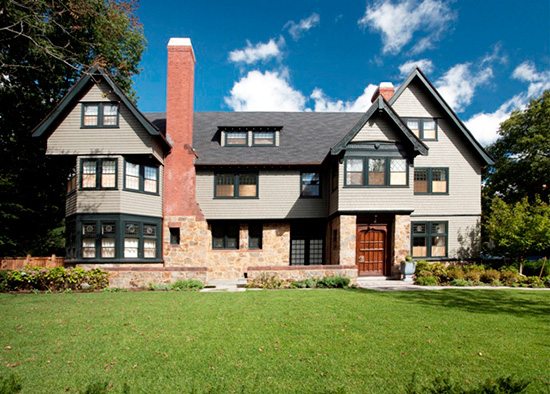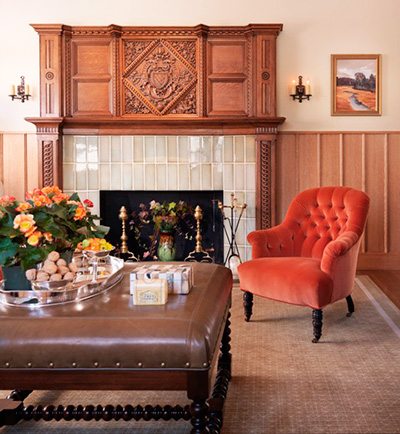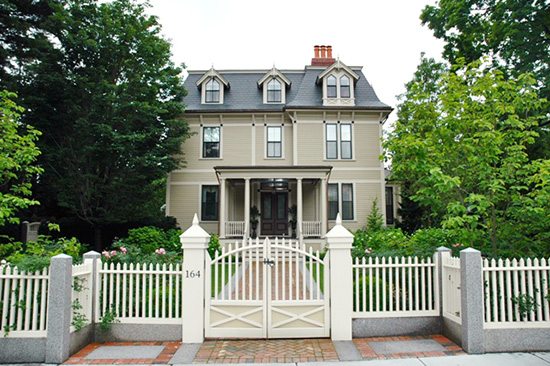Doug Hanna: Bringing Your Historic Home into This Century
February 11, 2014
Owning and restoring an historic property can be very rewarding, though at times also an unpredictable experience. Many owners of historic properties rightly view themselves as custodians, entrusted with the task of preserving and maintaining architectural details through the years. They often find, however, that the scope of restoration work can be difficult to gauge, and the requirements of local agencies that have jurisdiction over the property can vary widely.

This award-winning historic renovation captured the character of the original home
through an exterior restoration and landscaping. Photos by Eric Roth
Talk With the Experts
When working in an historic district, the town’s historical commission is your first stop. Learn the requirements, guidelines and restrictions for your project at the start. Don’t minimize the time and effort spent on this step; through many years of working on historic properties in the Boston area, we’ve learned that the process takes time. The best philosophy is to think of the historical officials as partners. A town’s historical commission has a wealth of knowledge, and may even offer suggestions or contacts to improve your project that you hadn’t considered. Often the historical commission or society will possess photographs and other historical evidence of the way your home looked through the years, allowing for restoration of lost details. Open communication with those agencies will make it easier to bring your project to the finish line, and may even help you earn a few concessions. There is no harm in trying to do a little horse-trading—for example, “I’d love to restore the back porch in every detail, but my budget only allows for doing the front porch, which is visible from the street…can we compromise on the back porch?” This may not work in every district; you’ll find out pretty quickly if it will fly or not. Still, remember that there’s a big difference between bargaining with colleagues, and trying to cheat the requirements. Playing by the rules is key to maintaining a good relationship with officials and helping your project move successfully through to completion.

The fireplace surround featured here is original to the house
and was found in the basement during renovation. It was
completely restored and is now the focal point of this room.
Piece Together the Puzzle
Even outside historic districts there are certain steps you should take to maintain the integrity and accuracy of your home’s details. Organization will go a long way here. Your architect should begin by documenting the architecture with photographs and measured drawings if possible. It will take the guesswork out of replicating the style down the road. The plans should show clearly which architectural components are to be saved and which are to be replicated. (Some of these decisions will probably need to be modified after investigating damaged areas.) Much like working on a puzzle, you won’t get the finished look you desire if the pieces are put back together the wrong way. You’ll need a contractor familiar with historical restoration, working with a thorough set of plans and specifications. Someone who doesn’t know what he’s doing can damage the integrity of the structure—and a piece of history may be lost. Paying for designers and contractors with a solid knowledge base is a smart investment.

This home, built in the 1800s, received a complete facelift—siding, trim,
slate-and-copper roof, new chimneys, porch, and bracket details.
Save Treasure from Trash
Here’s another tip: Don’t throw out architectural components just because they’re rotted. By saving a sample, you can show contractors exactly what you’re looking for in terms of authentic replacements. In some cases, modern epoxies may allow you to repair trim rather than replace it entirely. Qualified contractors will know when that’s appropriate. Sections of rotted running trim can have segments of new wood patched in. Just make sure that those replacement parts are made from wood that has a natural resistance to rot, so you’re not repeating the whole process again a few years down the road. All new components should be back-primed prior to installation. If parts need to be replaced entirely, it’s a fairly straightforward process to replicate old trim. Make sure that you save any custom-made cutting knives and other components fabricated by the mill shop for use in future repairs.

This custom staircase and banister are a reproduction of the original.
Make it a Labor of Love
Maintaining any home is a necessity in today’s competitive real estate market. But renovating a dusty historical gem is a labor of love. By taking the time to follow the rules, maintaining the integrity of your home’s historical details, and working with experienced designers and contractors, you’ll ensure that your property continues to add historical context and beauty to your community for years to come.
—Doug Hanna
Doug Hanna is president of S+H Construction, a multi-award-winning firm based in Cambridge, Massachusetts, that specializes in custom homebuilding, residential renovations, historical restorations, renewable energy, site work, and landscaping solutions.
Share
![NEH-Logo_Black[1] NEH-Logo_Black[1]](https://b2915716.smushcdn.com/2915716/wp-content/uploads/2022/08/NEH-Logo_Black1-300x162.jpg?lossy=1&strip=1&webp=1)






